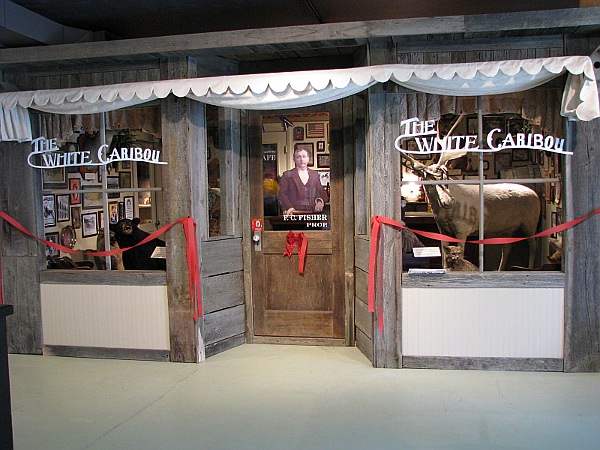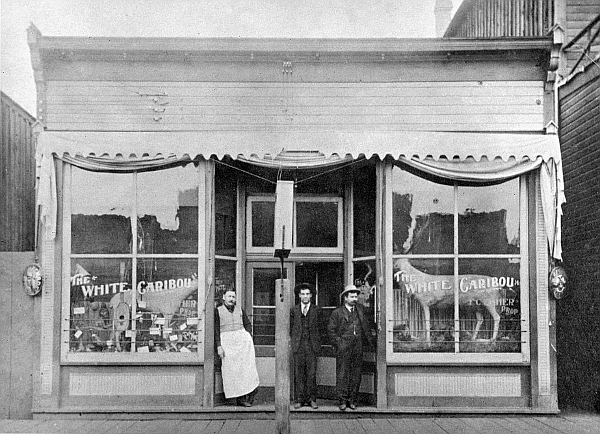White Caribou Bar dedicated
|
|
May 21, 2013 |
 |
| The
newest exhibit at the Boundary County
Museum is the White Caribou Bar,
dedicated in a ribbon cutting ceremony
on Saturday, May 18. |
|
It took a lot of people to bring back to life the old
White Caribou Bar, founded more than 100 years
ago in Bonners Ferry.
Fred Fisher opened the bar, which featured the
iconic Bonners Ferry white caribou, on Main
Street in 1905, and ran it until it closed four
years later in 1909.
At its dedication and ribbon cutting ceremony on
Saturday, Fisher was among many receiving
thanks, not only for opening the bar, but for
bringing in the mounted white caribou back in
the 1890s that has graced the museum for years.
"Most likely he was thinking that 'those Bonners
Ferry citizens in 2013 are going to cherish this
white caribou,'" Museum curator Sue Kemmis said
in her dedication speech.
In addition to Fisher, she also thanked his
great-great nephew, Hartley King, and the
families of Tot Smith and Paul Flinn, who
brought the white caribou home.
It took over 600 hours of volunteer labor and
love to create the exhibit, made possible in
part by a grant from the Idaho Humanities
Council and Rick Ardinger and Cindy Wang, who
helped the Historical Society Board; Jill
Nystrom, Don Morice, Cal Russell, Stephanie
Tucker, Dave and Dottie Gray and John Standal,
through the process.
Story continues below ...
 |
| The
White Caribou Bar as it was in its
hey-day. |
"Now to get something like this started," Kemmis
said, "there has to be an idea, and then someone
like Dottie Gray, who will write for the grant
money, then eagerly wait to see if you get it.
Dottie, as the project director, keeps everyone
moving forward so we can meet the grant
deadline. We thank Dottie. She's not done,
because now comes the final report."
Once the project started coming together,
Society historian Howard Kent began his research
on the White Caribou Bar, and writing the draft
narratives and interpretive boards gracing the
exhibit, a process that took considerable time
and many re-writes.
Next, Don Morice was asked how to go about
building a bar in a museum. With his plans in
hand, Terry Howe, Gene Andrews and Rod
LePoidevin went in just after Christmas, began
making chalk lines all over the museum floor and
stocked the back room with lumber from Idaho
Forest Group, who donated all the 2x4s, Pro X
and Home Depot. It wasn't long before the walls
were up and sheetrocked, windows in and painting
done. Gene and his wife, Pat, added shelves,
window frames and corbels.
While the work in the museum was going apace,
Terry and Andy Howe braved the snows of a
Boundary County winter to go out and gather the
barn wood needed for the project. Bonners Ferry
Glass worked to cut the glass for the bar front
and windows looking in. After the main work was
done came the detail: Marianne Duarte donated
wallpaper border and beaded curtains from the
Heath Estate and hung them with Dottie's help;
Caroline McNeill sewed the awning fabric
purchased at Sater's Auction and put them up
with the able help of Dave, Dottie and Howard.
The white caribou was a bit too dusty to grace
the new display; Debby Ackley tended to the
sprucing up, and Darlene Young set about
cleaning and/or repainting the bases of the
other mounted animals, picture frames and more.
Fred Nystrom, North Idaho Iron Works, painted
the windows with the proud name of the old bar,
and the crew realized that a bar wouldn't be a
bar unless it had a bar.
Raven Hawks, Roundheels Gun and Pawn, said the
business was closing and invited the crew to
come see if they had anything that could help
the exhibit. John Standal went to take a look,
and came back to report that the bar had been
found; Raven and owner Bill Munson graciously
donated the counter they'd used for years.
Don Morice and two young helpers were soon
wheeling it down the street to its new home,
where it was raised to be tall enough to belly
up to, stripped and stained, and fitted with a
brass footrail.
Back now to Howard Kent. While all the work was
underway, he and Mary Ann Kruger, Dottie and
Sue, along with project scholar Nancy Renk and
editor John O'Connor were busy converting the
raw research into exhibit graphics, the plaques,
interpretive boards, brochures and more. Once
the editing was done, Mary Ann created the
layout and Fleet Graphics printed the finished
products.
Even a poem from the back of Fred Fisher's
business card was incorporated, available at the
museum on postcards.
After thanking all these people and more, Sue
stepped aside as Hartley King cut the ribbon, an
image of his great-great uncle peering proudly
out the door at him.
The exhibit officially opened, everyone then
enjoyed a round of beer on the house ... root
beer, of course.
|
|
Questions or comments about this
article?
Click here to e-mail! |
|
|
|
|

